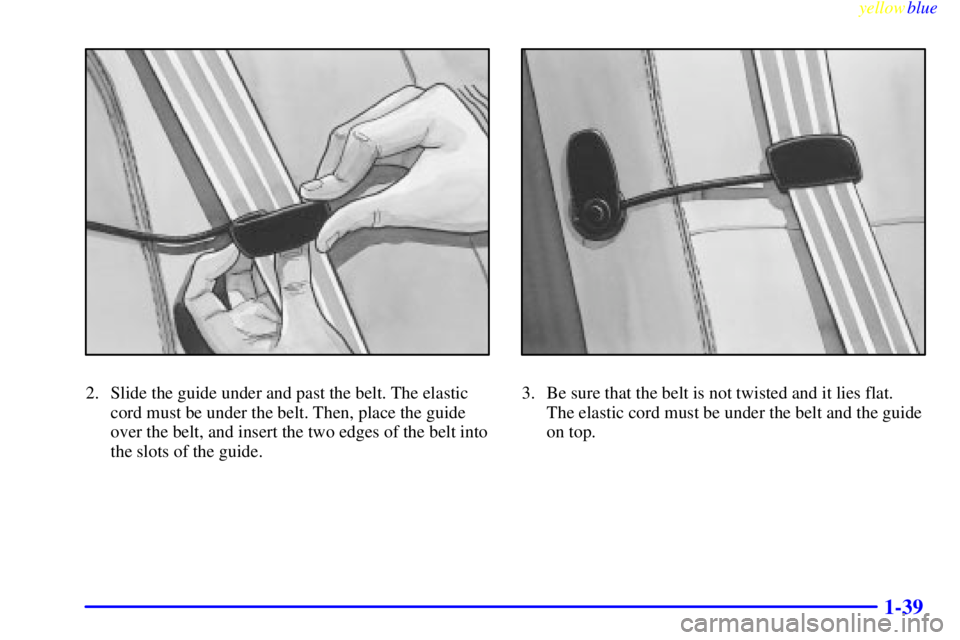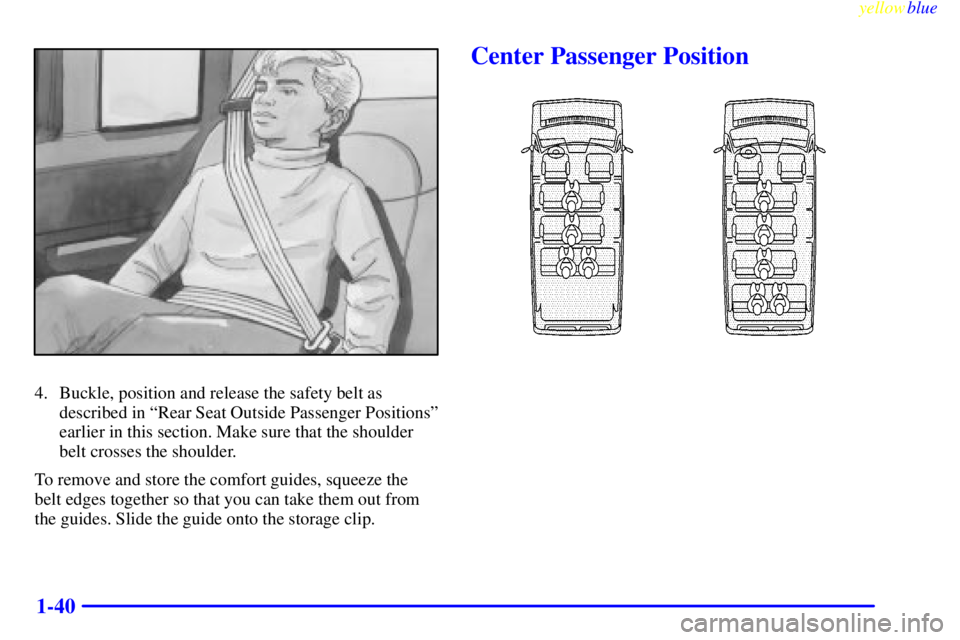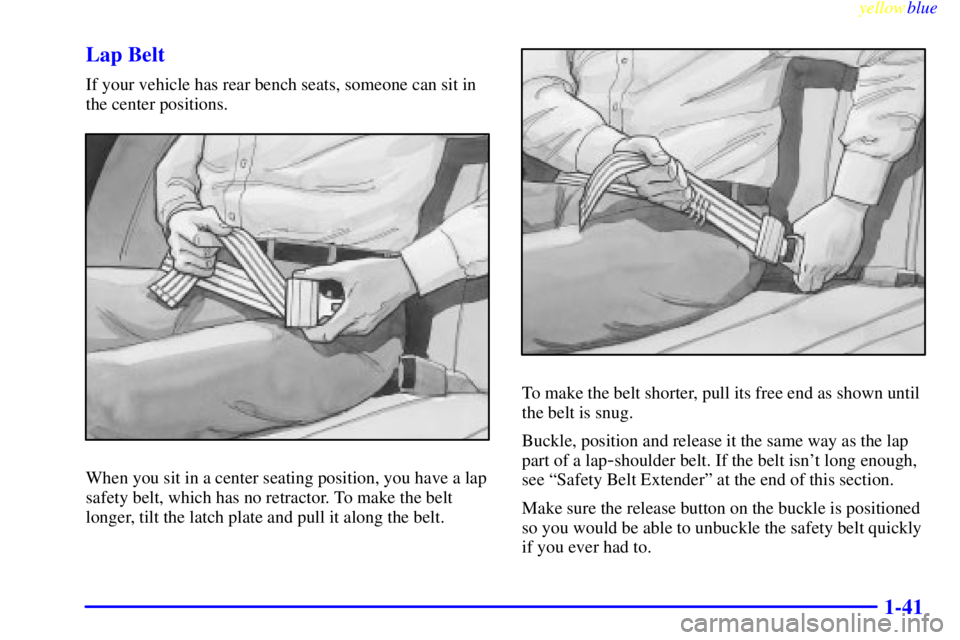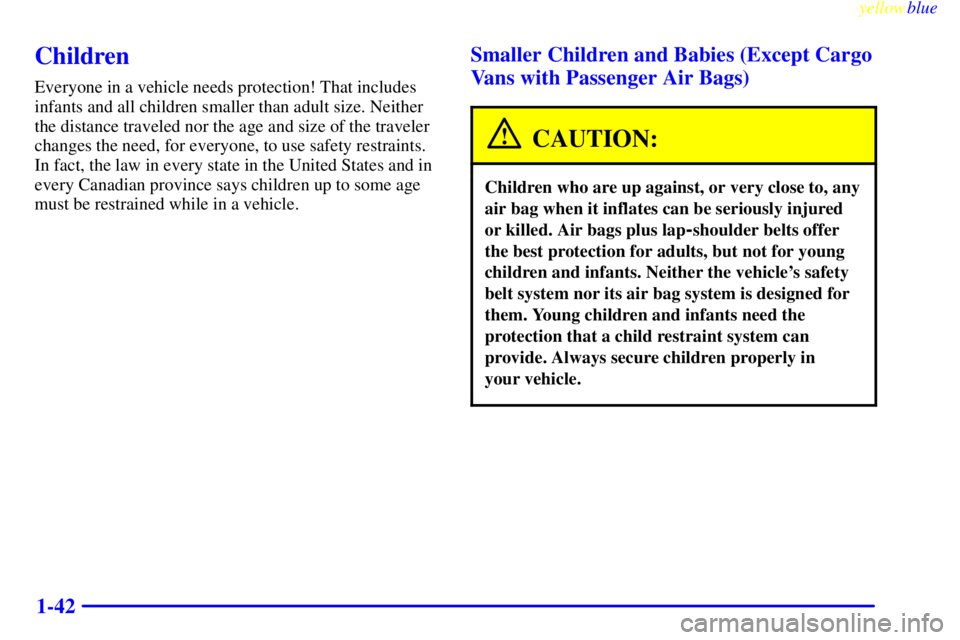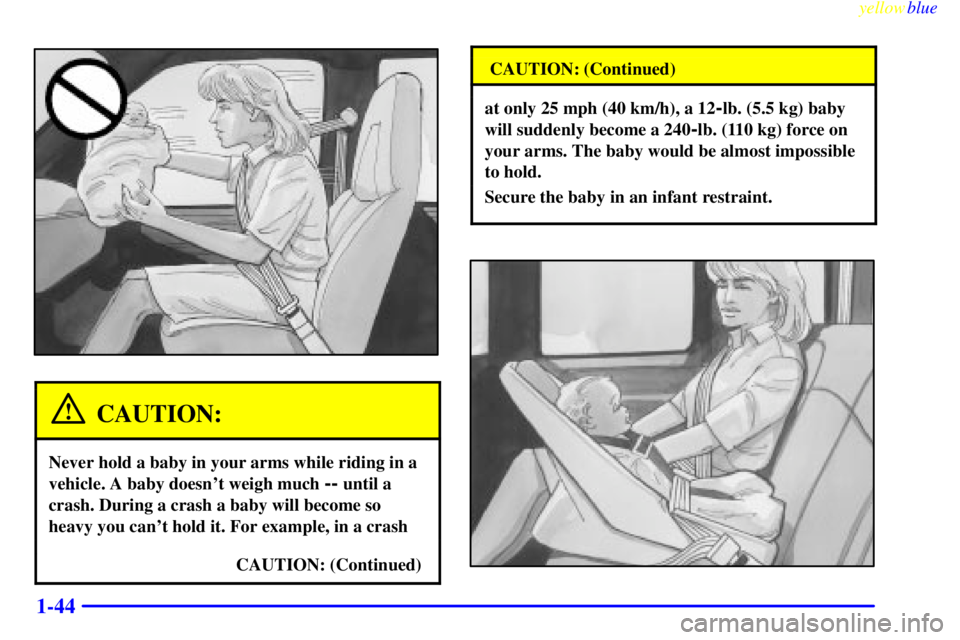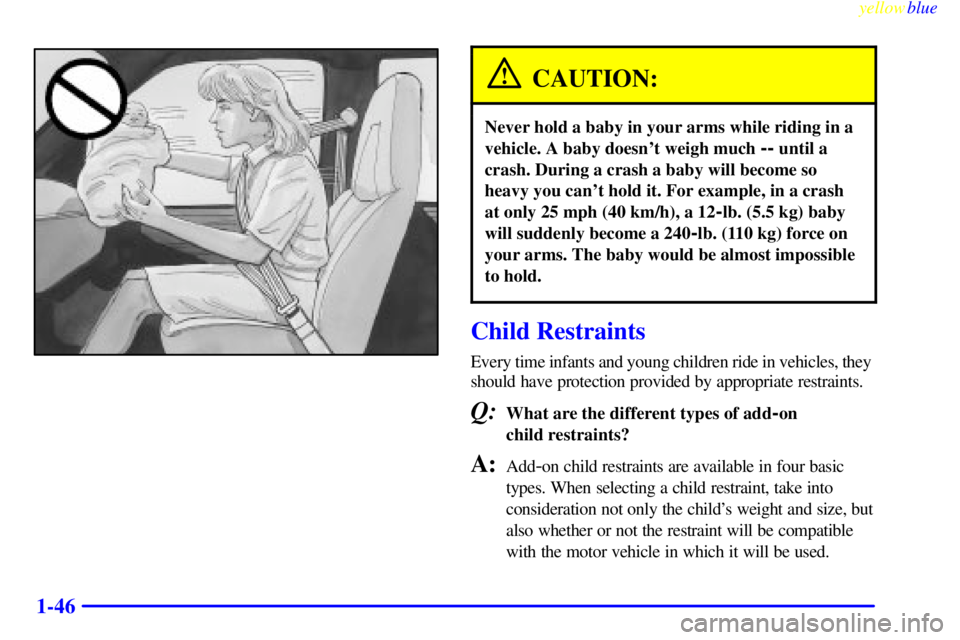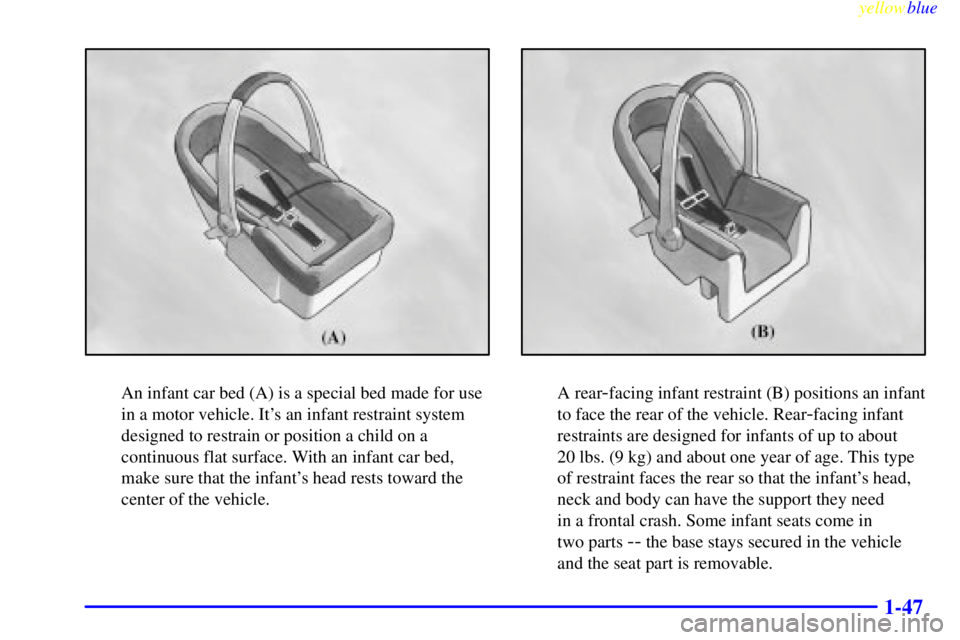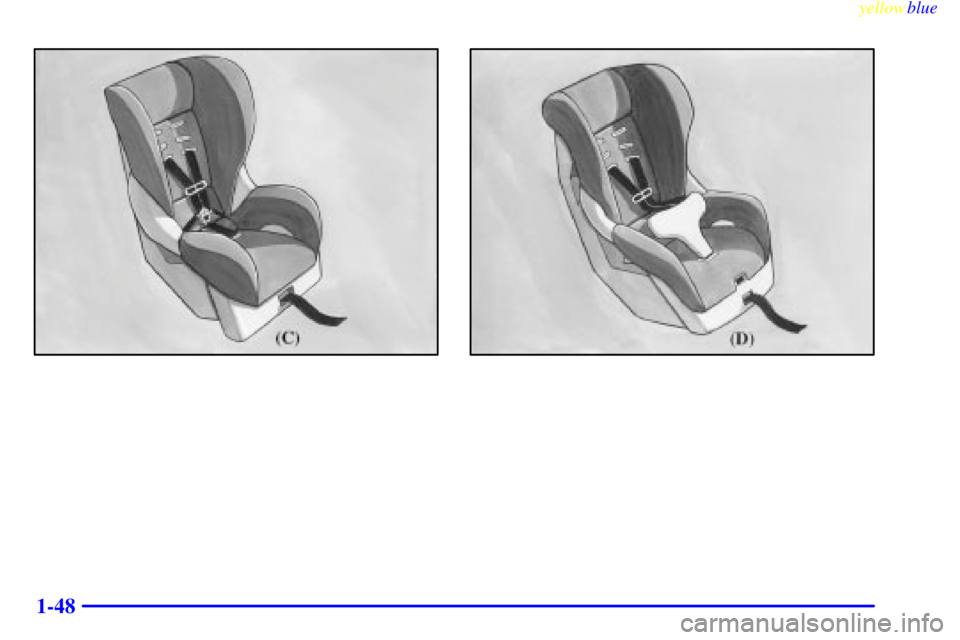GMC SAVANA 1999 Workshop Manual
Manufacturer: GMC, Model Year: 1999,
Model line: SAVANA,
Model: GMC SAVANA 1999
Pages: 398, PDF Size: 2.67 MB
GMC SAVANA 1999 Workshop Manual
SAVANA 1999
GMC
GMC
https://www.carmanualsonline.info/img/44/35600/w960_35600-0.png
GMC SAVANA 1999 Workshop Manual
Trending: radiator cap, air condition, roof, radio controls, traction control, air suspension, heater
Page 51 of 398
yellowblue
1-39
2. Slide the guide under and past the belt. The elastic
cord must be under the belt. Then, place the guide
over the belt, and insert the two edges of the belt into
the slots of the guide.3. Be sure that the belt is not twisted and it lies flat.
The elastic cord must be under the belt and the guide
on top.
Page 52 of 398
yellowblue
1-40
4. Buckle, position and release the safety belt as
described in ªRear Seat Outside Passenger Positionsº
earlier in this section. Make sure that the shoulder
belt crosses the shoulder.
To remove and store the comfort guides, squeeze the
belt edges together so that you can take them out from
the guides. Slide the guide onto the storage clip.
Center Passenger Position
Page 53 of 398
yellowblue
1-41 Lap Belt
If your vehicle has rear bench seats, someone can sit in
the center positions.
When you sit in a center seating position, you have a lap
safety belt, which has no retractor. To make the belt
longer, tilt the latch plate and pull it along the belt.
To make the belt shorter, pull its free end as shown until
the belt is snug.
Buckle, position and release it the same way as the lap
part of a lap
-shoulder belt. If the belt isn't long enough,
see ªSafety Belt Extenderº at the end of this section.
Make sure the release button on the buckle is positioned
so you would be able to unbuckle the safety belt quickly
if you ever had to.
Page 54 of 398
yellowblue
1-42
Children
Everyone in a vehicle needs protection! That includes
infants and all children smaller than adult size. Neither
the distance traveled nor the age and size of the traveler
changes the need, for everyone, to use safety restraints.
In fact, the law in every state in the United States and in
every Canadian province says children up to some age
must be restrained while in a vehicle.
Smaller Children and Babies (Except Cargo
Vans with Passenger Air Bags)
CAUTION:
Children who are up against, or very close to, any
air bag when it inflates can be seriously injured
or killed. Air bags plus lap
-shoulder belts offer
the best protection for adults, but not for young
children and infants. Neither the vehicle's safety
belt system nor its air bag system is designed for
them. Young children and infants need the
protection that a child restraint system can
provide. Always secure children properly in
your vehicle.
Page 55 of 398

yellowblue
1-43
CAUTION:
Smaller children and babies should always be
restrained in a child or infant restraint. The
instructions for the restraint will say whether it is
the right type and size for your child. A very
young child's hip bones are so small that a
regular belt might not stay low on the hips, as it
should. Instead, the belt will likely be over the
child's abdomen. In a crash, the belt would apply
force right on the child's abdomen, which could
cause serious or fatal injuries. So, be sure that
any child small enough for one is always properly
restrained in a child or infant restraint.
Infants need complete support, including support for the
head and neck. This is necessary because an infant's
neck is weak and its head weighs so much compared
with the rest of its body. In a frontal crash, an infant
in a rear
-facing restraint settles into the restraint, so the
crash forces can be distributed across the strongest part
of the infant's body, the back and shoulders. A baby
should be secured in an appropriate infant restraint.
This is so important that many hospitals today won't
release a newborn infant to its parents unless there is an
infant restraint available for the baby's first trip in a
motor vehicle.
Page 56 of 398
yellowblue
1-44
CAUTION:
Never hold a baby in your arms while riding in a
vehicle. A baby doesn't weigh much
-- until a
crash. During a crash a baby will become so
heavy you can't hold it. For example, in a crash
CAUTION: (Continued)
CAUTION: (Continued)
at only 25 mph (40 km/h), a 12-lb. (5.5 kg) baby
will suddenly become a 240
-lb. (110 kg) force on
your arms. The baby would be almost impossible
to hold.
Secure the baby in an infant restraint.
Page 57 of 398
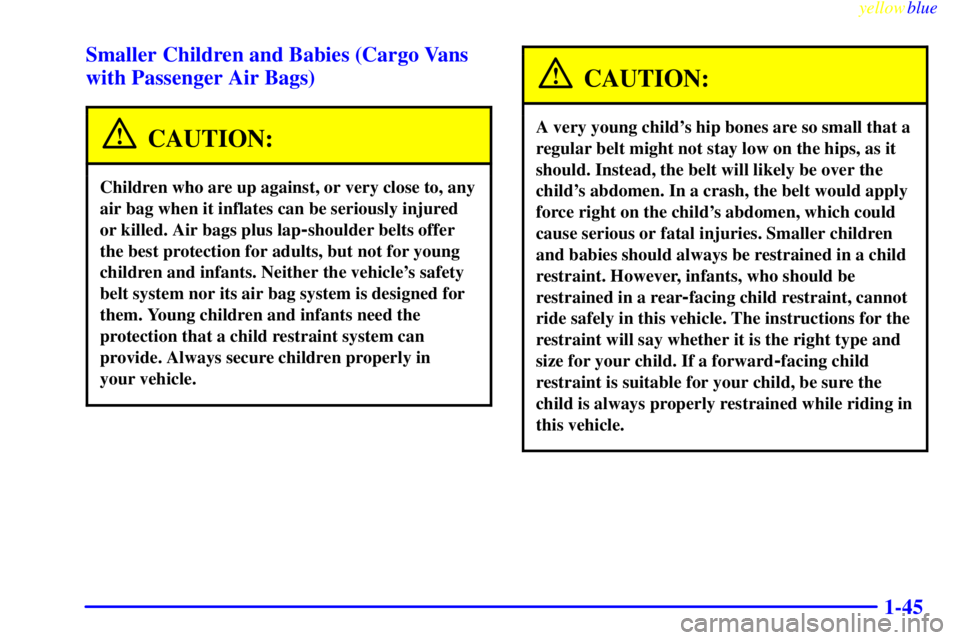
yellowblue
1-45 Smaller Children and Babies (Cargo Vans
with Passenger Air Bags)
CAUTION:
Children who are up against, or very close to, any
air bag when it inflates can be seriously injured
or killed. Air bags plus lap
-shoulder belts offer
the best protection for adults, but not for young
children and infants. Neither the vehicle's safety
belt system nor its air bag system is designed for
them. Young children and infants need the
protection that a child restraint system can
provide. Always secure children properly in
your vehicle.
CAUTION:
A very young child's hip bones are so small that a
regular belt might not stay low on the hips, as it
should. Instead, the belt will likely be over the
child's abdomen. In a crash, the belt would apply
force right on the child's abdomen, which could
cause serious or fatal injuries. Smaller children
and babies should always be restrained in a child
restraint. However, infants, who should be
restrained in a rear
-facing child restraint, cannot
ride safely in this vehicle. The instructions for the
restraint will say whether it is the right type and
size for your child. If a forward
-facing child
restraint is suitable for your child, be sure the
child is always properly restrained while riding in
this vehicle.
Page 58 of 398
yellowblue
1-46
CAUTION:
Never hold a baby in your arms while riding in a
vehicle. A baby doesn't weigh much
-- until a
crash. During a crash a baby will become so
heavy you can't hold it. For example, in a crash
at only 25 mph (40 km/h), a 12
-lb. (5.5 kg) baby
will suddenly become a 240
-lb. (110 kg) force on
your arms. The baby would be almost impossible
to hold.
Child Restraints
Every time infants and young children ride in vehicles, they
should have protection provided by appropriate restraints.
Q:What are the different types of add-on
child restraints?
A:Add-on child restraints are available in four basic
types. When selecting a child restraint, take into
consideration not only the child's weight and size, but
also whether or not the restraint will be compatible
with the motor vehicle in which it will be used.
Page 59 of 398
yellowblue
1-47
An infant car bed (A) is a special bed made for use
in a motor vehicle. It's an infant restraint system
designed to restrain or position a child on a
continuous flat surface. With an infant car bed,
make sure that the infant's head rests toward the
center of the vehicle.A rear-facing infant restraint (B) positions an infant
to face the rear of the vehicle. Rear
-facing infant
restraints are designed for infants of up to about
20 lbs. (9 kg) and about one year of age. This type
of restraint faces the rear so that the infant's head,
neck and body can have the support they need
in a frontal crash. Some infant seats come in
two parts
-- the base stays secured in the vehicle
and the seat part is removable.
Page 60 of 398
Trending: audio, sensor, odometer, trunk, spare tire location, oil reset, key
